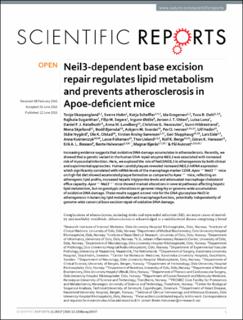| dc.contributor.author | Skarpengland, Tonje | |
| dc.contributor.author | Holm, Sverre | |
| dc.contributor.author | Scheffler, Katja | |
| dc.contributor.author | Gregersen, Ida | |
| dc.contributor.author | Dahl, Tuva Børresdatter | |
| dc.contributor.author | Suganthan, Rajikala | |
| dc.contributor.author | Segers, Filip | |
| dc.contributor.author | Østlie, Ingunn | |
| dc.contributor.author | Otten, Jeroen J.T. | |
| dc.contributor.author | Gomez, Luisa Fernanda Luna | |
| dc.contributor.author | Ketelhuth, Daniel F.J. | |
| dc.contributor.author | Lundberg, Anna M. | |
| dc.contributor.author | Neurauter, Christine Gran | |
| dc.contributor.author | Hildrestrand, Gunn Annette | |
| dc.contributor.author | Skjelland, Mona | |
| dc.contributor.author | Bjørndal, Bodil | |
| dc.contributor.author | Svardal, Asbjørn M. | |
| dc.contributor.author | Iversen, Per Ole | |
| dc.contributor.author | Hedin, Ulf | |
| dc.contributor.author | Nygård, Ståle | |
| dc.contributor.author | Olstad, Ole Kristoffer | |
| dc.contributor.author | Krohg-Sørensen, Kirsten | |
| dc.contributor.author | Slupphaug, Geir | |
| dc.contributor.author | Eide, Lars | |
| dc.contributor.author | Kusnierczyk, Anna | |
| dc.contributor.author | Folkersen, Lasse | |
| dc.contributor.author | Ueland, Thor | |
| dc.contributor.author | Berge, Rolf Kristian | |
| dc.contributor.author | Hansson, Göran K. | |
| dc.contributor.author | Biessen, Erik A.L. | |
| dc.contributor.author | Halvorsen, Bente | |
| dc.contributor.author | Bjørås, Magnar | |
| dc.contributor.author | Aukrust, Pål | |
| dc.date.accessioned | 2020-03-25T09:32:04Z | |
| dc.date.available | 2020-03-25T09:32:04Z | |
| dc.date.created | 2016-08-10T11:41:45Z | |
| dc.date.issued | 2016 | |
| dc.identifier.issn | 2045-2322 | |
| dc.identifier.uri | https://hdl.handle.net/11250/2648498 | |
| dc.description.abstract | Increasing evidence suggests that oxidative DNA damage accumulates in atherosclerosis. Recently, we showed that a genetic variant in the human DNA repair enzyme NEIL3 was associated with increased risk of myocardial infarction. Here, we explored the role of Neil3/NEIL3 in atherogenesis by both clinical and experimental approaches. Human carotid plaques revealed increased NEIL3 mRNA expression which significantly correlated with mRNA levels of the macrophage marker CD68. Apoe−/−Neil3−/− mice on high-fat diet showed accelerated plaque formation as compared to Apoe−/− mice, reflecting an atherogenic lipid profile, increased hepatic triglyceride levels and attenuated macrophage cholesterol efflux capacity. Apoe−/−Neil3−/− mice showed marked alterations in several pathways affecting hepatic lipid metabolism, but no genotypic alterations in genome integrity or genome-wide accumulation of oxidative DNA damage. These results suggest a novel role for the DNA glycosylase Neil3 in atherogenesis in balancing lipid metabolism and macrophage function, potentially independently of genome-wide canonical base excision repair of oxidative DNA damage. | en_US |
| dc.language.iso | eng | en_US |
| dc.publisher | Nature Research | en_US |
| dc.rights | Navngivelse 4.0 Internasjonal | * |
| dc.rights.uri | http://creativecommons.org/licenses/by/4.0/deed.no | * |
| dc.title | Neil3-dependent base excision repair regulates lipid metabolism and prevents atherosclerosis in Apoe-deficient mice | en_US |
| dc.type | Peer reviewed | en_US |
| dc.type | Journal article | en_US |
| dc.description.version | publishedVersion | en_US |
| dc.source.volume | 6:28337 | en_US |
| dc.source.journal | Scientific Reports | en_US |
| dc.identifier.doi | 10.1038/srep28337 | |
| dc.identifier.cristin | 1371776 | |
| dc.description.localcode | This work is licensed under a Creative Commons Attribution 4.0 International License. The images or other third party material in this article are included in the article’s Creative Commons license, unless indicated otherwise in the credit line; if the material is not included under the Creative Commons license, users will need to obtain permission from the license holder to reproduce the material. To view a copy of this license, visit http://creativecommons.org/licenses/by/4.0/ | en_US |
| cristin.ispublished | true | |
| cristin.fulltext | original | |
| cristin.qualitycode | 1 | |

